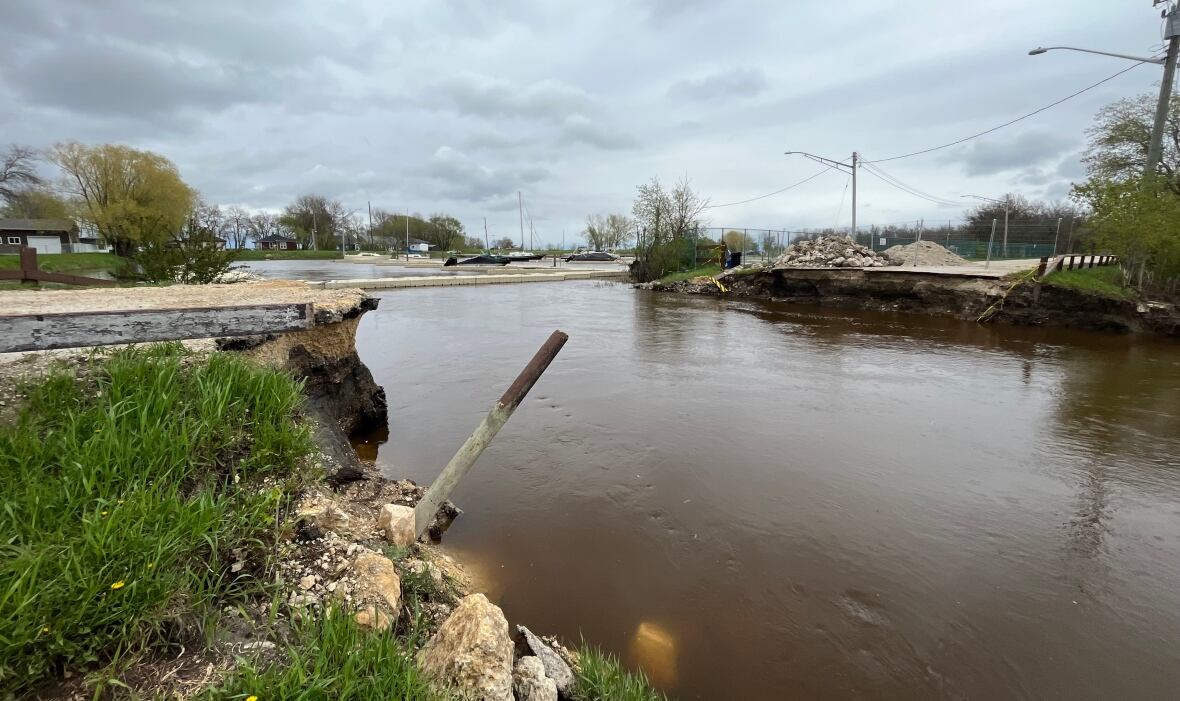Thousands of flood-damaged sites need repairs in Manitoba, tab already tens of millions and growing
Impacts of wet spring for agriculture industry alone estimated to be $24M-$36M

The devastation from the wettest Manitoba spring in over a century is still being catalogued, but officials say there are thousands of sites that need repairs, with a repair tab that is already into the tens of millions of dollars.
"It will be a significant recovery program," Sarah Thiele, deputy minister of transportation and infrastructure, said during a news conference in Manitoba's Interlake region Thursday morning.
She addressed media as a torrent of water rushed in the background, where a section of Highway 222 collapsed near Lakeside Road, north of Gimli.
There are already about 2,000 municipal sites on the repair list. The index of provincial sites is still being written up, "and our list is growing," Thiele said.
"We're still assessing and we still have areas that are under water that we can't look at yet."

Asked for a cost estimate, Thiele said "it's very early days for us to put a number on it, but we're already in the tens of millions for sure. So that number will grow."
Thiele, Transportation and Infrastructure Minister Doyle Piwniuk and Agriculture Minister Derek Johnson were given a flood tour of the Interlake on yet another rainy day.
"We saw a lot of devastation, especially when it comes to municipal roads and provincial highways — and a lot of water covering fields," Piwniuk said.
Widespread flooding has stretched the province's ability to respond on multiple fronts. In the Interlake, Peguis First Nation experienced a historic flood that damaged hundreds of homes and forced nearly 1,900 people to leave.
Property owners in the southeast, particularly in the Whiteshell Provincial Park, have anxiously watched the water level on the Winnipeg River, which has continued to rise, but at a slower pace in recent days.
In the west, an evacuation order was briefly in place this week for some residents around Dauphin Lake. The region has experienced repeated flash flooding as Colorado low weather systems moved across the province.
And in the south, the Red River is starting to recede after what is the sixth-largest flood on record by volume, based on flows recorded at Emerson and Ste. Agathe.

"It's like anywhere in the province. It feels like it's coming in every direction for us," Piwniuk said.
"We're having a crisis right now but now we can learn from all these floods."
Piwniuk, who said he will visit western Manitoba soon, said the tours not only allow officials to assess damage, but "to look at the infrastructure that we need to invest in" for better protection from future events.
A similar approach has been taken in the Red River Valley following previous floods. As a result, infrastructure damage in 2022 is much less compared to the floods of 1997 or 2009, he said.
Changes in some areas are very likely, including new bridges over some spots rather than culverts under roads, Piwniuk said.

Some of the damage that will need to be repaired includes roads purposely cut by provincial crews to allow water through.
"We need to make sure the water flows. If it's going to push back, then we get more destruction when it comes to properties," Piwniuk said, adding the province works with municipalities to determine which which roads to cut.
Some damage from this spring's flood will take years to fix, while some can be repaired over the next few months, Thiele said.
In many cases, temporary fixes will be made to ensure essential access for emergency vehicles. Crews will return later for a permanent repair, she said.
Flood-related costs are shared with the federal government under disaster assistance funding programs, Thiele said.

She was asked, though, if Ottawa would consider the recent multiple rain events in Manitoba a source of "spring flooding," which is normally caused in Manitoba by snowmelt.
"I think it's too early to be having those discussions at that level, but right now there's no doubt that this has been a significant, continuous flood event. It will be a spring 2022 single flood event," she said.
The effect of the wet spring has been significant on the agricultural industry as well.
"We're looking at impacts around $24-$36 million," said Johnson, noting there are multiple insurance claims producers can access, including for excess moisture.
With files from Cameron MacLean


